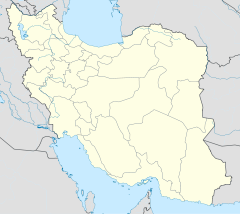- Operation Beit ol-Moqaddas
-
Operation Undeniable Victory Part of Iran–Iraq War Date 24th April 1982- 22nd May 1982 Location Khuzestan, South-West Iran Result Decisive Iranian victory Territorial
changesIranians recapture Khorramshahr Belligerents  Iraq
Iraq Iran
IranCommanders and leaders  Hossein Kharrazi
Hossein KharraziStrength 70,000 fighters 70,000 fighters[citation needed] Casualties and losses 16,000 killed[citation needed] 19,000 captured
6,000 killed 24,000 wounded
Related U.S. operations in bold
Kaman 99 – Abadan – 1st Khorramshahr – Morvarid – Dezful – Undeniable Victory – 2nd Khorramshahr – Samen-ol-A'emeh – Jerusalem Way – Jerusalem – Ramadan – Before the Dawn – Dawn 1 – Dawn 2 – Dawn 3 – Dawn 4 – Dawn 5 – Dawn 6 – Marshes – Kheibar – Badr – Al-Anfal Campaign – 1st Al Faw – Dawn 8 – Karbala 4 – Karbala-5 – Karbala-6 – USS Stark Incident – Karbala Ten – Nasr 4 – Earnest Will – Prime Chance – Eager Glacier – Nimble Archer – Halabja – Zafar 7 – 2nd Al Faw – Praying Mantis – Air Flight 655 Incident – MersadOperation Beit ol-Moqaddas (or Operation Jerusalem) was an Iranian operation conducted during the Iran–Iraq War. The operation was a success, in as so far as it achieved its standing aim of evicting Iraqi troops from the Iranian city of Khorramshahr. This operation, coupled with Operation Jerusalem Way, and Operation Undeniable Victory, succeeded in evicting Iraqi troops from southern Iran.
The numbers of casualties sustained by Iraq and Iran are unknown; but it is likely that there was not as marked a difference between both sides as there would be when Iran was losing thousands in one campaign against a relatively paltry Iraqi dead and wounded. Iran was using massed human-wave attacks of Pasdaran and Basij fighters, which it would come to rely on later in the war from 1983 onwards. However, they were supporting these attacks with sufficient artillery and aerial support, and the fighters acted alongside regular Iranian troops, who were much better trained than the poorly-equipped Islamic Revolutionary fighters.
Prelude
On September 22, 1980, because of his desire that Iraq should have complete dominance over the Shatt al-Arab(or the Arvand Rūd) waterway, Iraqi President Saddam Hussein declared war against Iran and launched a land invasion of southern Iran, although operations did occur elsewhere on the Iran-Iraq border. After achieving stunning successes, Saddam Hussein amazingly ordered that the Iraqi troops 'dig-in' on the front line. He hoped that this would show the world that he cared about the fate of the Iranian people, and that he was only concerned with achieving his aim of securing the entire Shatt al-Arab waterway; which had been under dispute since the 1975 Algiers Agreement had been under some strain. That agreement was itself an attempt to settle the historical dispute over possession of the waterway. However, since the Islamic Revolution of Iran in 1979; Iraq had felt that it was necessary to assume what it wanted through force, and that it was no use trying to negotiate with the revolutionary Iranian government.
Once the Iraqi forces had settled, the Iranians could begin planning a series of operations designed to evict the Iraqis from southern Iran, of which Operation Jerusalem Way was one.
Battle
The Iranians attacked, with some 70,000 fighters in the Ahvaz-Susangerd area. The Iraqi forces in the area withdrew, and planned to mount a defence at Khorramshahr.
The Iraqis launched a counter-offensive on the 20th May. However, despite its scale, the Iranians were able to repulse the attack.
On the 22nd May, the Iranians Liberated Khorramshahr; the vitally strategically important Iranian city whose capture by Iraq had been the low-point of Iranian fortunes in the early days of the war
The Iraqis were ordered to retreat, although many had done when Khorramshar had fallen, back into Iraq. The Iranians captured 12,000 Iraqi troops and a substantial amount of Iraqi military hardware.
References
- The Iran–Iraq War 1980-1988; Karsh, Efraim; Osprey Publishing; 2002
Categories:- 1982 in Iran
- Battles involving Iran
- Battles involving Iraq
- Military operations of the Iran–Iraq War
- History of Khuzestan Province
Wikimedia Foundation. 2010.

